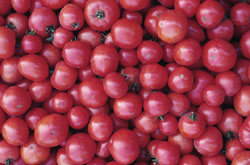Better tasting, healthier tomatoes
Tomato production in Europe is widespread, hence even minor improvements in taste and yield can be highly valuable. The European Commission funded a four-year project to address current obstacles to tomato farming. The approach involved genetic engineering, which aims to identify genes responsible for various traits and to enhance or hinder their expression accordingly. The project coordinator, Stazione Zoologica, undertook research on photoreceptors, special plant cells that respond to light. Phytochrome and other photoreceptors were modified and the resulting tomatoes were cultivated in greenhouses. Effects on plant structure were monitored as well as the sugar content (brix), firmness and other traits of the fruit. Use of advanced DNA fingerprinting techniques, such as complementary DNA Amplified Fragment Length Polymorphism (cDNA-AFLP), facilitated gene isolation in the photomorphogenic strains. Scientists also subjected the seedlings to darkness to help reveal extraordinary photoreceptor response. Progress in the isolation of atroviolacea and anthocyanin fruit genes is expected to ultimately contribute to the creation of tomatoes with elevated levels of beneficial antioxidants. Furthermore, by suppressing the DET1 gene carotenoid and flavonoid content were increased and thus incorporating additional health benefits.






